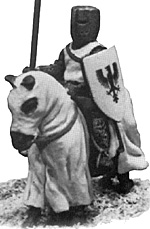 Edited by Raymond Estabrook and Marjorie Parker
Edited by Raymond Estabrook and Marjorie Parker
Playtesters: David Parker, Jeff Estabrook, Andy Niven, John MacCone
You suffer many things in the name of Christ: wretchedness, poverty, nakedness, persecution, need, sickness, hunger, thirst, and other things of this kind."
As many of you must know the First Crusade (1095-1101) was not the first or last war between the Muslim and European cultures. The Spanish nobility have been fighting an ongoing war with the Moors since the 8th century when the Iberian Peninsula was first invaded by the Saracen. In addition, just four years prior to the call for the First Crusade a Norman Count, one Roger I of Hauteville conquered and settled the Muslim controlled island of Sicily. The First Crusade actually begins when the wondrous Pope Urban II, claiming direct authorization of Christ, called for a war against the "barbarians" that were threatening the Eastern Church and Byzantium itself. He, in fact, was using the concept of a Holy War or Jihad to instigate the First Crusade. This wondrous Pope appealed to all the knights of Europe in simple terms. Speaking of a vendetta, he asked them to restore the honor of Christ and of Christianity. At this time the feudal knights of Europe were struggling to define their own meaning of existence - were they mere killing machines, or was there a greater call than that. As more of them began to feel the call of chivalry and the concept of honor and prestige many of them started out on the First Crusade for these reasons. But as time has shown, many more had a different reason entirely.
The knight of these times often looked to his family and his past for a reason to justify his life of violence. He drew on legends of Charlemagne, King Arthur and Roland as folk heroes. By the time of The First Crusade knighthood had begun to move away from it's violent roots towards a new identity. The Crusades afforded them a place to practice the idea of knightly service and honor. It was said that the soon to be ruler of Jerusalem, Duke Godfrey of Bouillon could trace his family line back to Charles the Great, who, according to legend, had made a pilgrimage to Jerusalem in the Dark Ages. Godfrey chose to follow the same path Charles had used, following in his ancestor's footsteps. The Crusades were to eventually impact most levels of western society as the knight, the common soldier and even the peasant became a soldier in the army of God.
During the summer of 1095, Pope Urban II initiated the First Crusade. Starting with a sermon to a group of bishops in southern France, Urban II started an exodus that would span almost seven centuries. Earlier that same year, the Byzantine Emperor Alexius had asked for help against the Turks, who were threatening the Byzantine Empire. Pope Urban II, wishing a more open relationship with the east, called for a Crusade to retake the Holy City of Jerusalem from the "infidel". This was to end up being far more than Alexius had expected. He had really only been looking for a few thousand mercenaries for his army. What he got was much more than he ever imagined or bargained for.
Looking back on this time as we do with hindsight Pope Urban II appears to have had two goals in mind for the men who went on his Crusade. First - to liberate the Eastern Christians from the Turks by driving them out of the territory of Byzantine Empire. Second - to open a land route to the Holy City of Jerusalem and recapture it in the Pope's own name.
To thoroughly use and understand this supplement you will need the Day Of Battle rule set. Day Of Battle is a miniatures army-role-playing game set originally in western Europe during the Feudal period (AD1100-AD1250). If you haven't tried a game like this before, you're in for a special time. You and one or more friends gather round a table covered with miniature soldiers, dice, model scenery and using your active imaginations take on the roles of player characters called leaders and heroes. Each one of you will try to complete your leader's goals, defeat scurrilous enemies, gather honor and attempt to avoid being captured and held for ransom, or worse, killed.
Think of your leader as a character out of a book or a movie, acting out mighty deeds or feats of arms for all to see. In the case of this book he or she is a character in the First Crusade, or facing it. With some imagination, and a little luck, he will pull through to do battle repeatedly. As you learn the tactics of this period you will gain more victories.
This supplement contains all of the rules you will need to play battles during the First Crusade using the Day Of Battle rules. All measurements in this supplement are given for 25mm figures. If you use 15mm figures you will need to reduce all measurements to sixty percent. Figures are based together on stands called Companies (Cos.). These Cos. sizes are regulation WRG 7th Edition. As in WRG all Cos. share a common width. This width is 60mm for 25mm figures and 36-40mm for 15mm figures. The depth of a Cos. is not as important and should be just deep enough to allow the mounting of a figure. This depth is usually 20mm for foot and 40mm for horse in the 25mm scale. For example, a 25mm scale figure armed with a light crossbow has a range of 20", A 15mm scale figure armed with a light crossbow has a range of 12". A 25mm light cross bow is has a Cos. size of 60mm wide by 20mm deep. A 15mm light cross bow has a Cos. size of 36mm wide by 12mm deep. In either case there are three figures mounted on a Cos.
The following rules are modified from Day Of Battle when any of the armies in this supplement are used.
Table Set Up The table width (in feet) is determined by adding up the final total number of army points (including handicaps) for both armies and dividing by 16; fractions are rounded naturally. Table depth is always 4'. Some armies have a handicap which is listed on their Army Profile. This used to help balance a game. For example, a 45 point Crusader army engages a 45 point Seljuq Turk army. The Turks have a handicap of +5 which gives them a total 50 army points. The total number of army points in the battle is 95. This is divided by 16 for a result of 5.9, which rounds up to 6. The table size for this battle will be 6' by 4'.
Table Deployment In the original Day Of Battle rules both armies are allowed to deploy up to 12" from their rear table edge. Skirmish troops may deploy anywhere within this zone. Other troops must be at least 6" in from either flank. This deployment is modified when facing any Eastern Armies in the First Crusader Supplement other then the Crusaders themselves.
Western Armies: If facing an Eastern Army must deploy at least 6" on but not greater than 15" on from their rear table edge. Skirmish troops may deploy anywhere within this zone. Other troops must be at least 12" in from either flank
Response to a charge is modified by using the new Crusader Response Chart. These new responses reflect the different style of fighting in this period.
For example, horse archers were one of the most common troop type deployed by the Eastern nations. Their formation and movement was such that they could move like birds in flight. The hardest task the Crusaders had was to close with them for combat. They were usually able to dart in, fire off their weapons and flee out of charge distance. Troops like this demand special rules that allow them to act as themselves. They cannot be expected to react like the skirmish troops of Western Europe.
Mounting And Dismounting Of Knights Knights that begin a game mounted may dismount once during the battle. Once they have done so they must fight on foot for the duration of the battle. Such an action is considered a maneuver for command point cost. Dismounted knights have their own statistics on the Crusader Army Profile. While dismounted they count as spearmen against cavalry and men at arms against all others. While dismounted a Cos. of horse holders representing the pages and horses must be placed within 3" of the knights. If the horse holders are contacted by an enemy unit they are lost. This loss counts as defeating knights in combat for honor points for the leader that contacted them (see Honor Points).
Eastern Leaders Social Rank Chart The eastern social strata was different from that of the west. To maintain some continuity between the two eastern leaders are given new titles for their social ranks. These titles may not match up exactly with their historical usage, but serve to add flavor to the game.
Eastern Spearmen Eastern spearmen are always based 3 figures per Cos. These soldiers were never expected to stand up to the onslaught of western knights. Furthermore they themselves usually represent a mixture of troops within the Cos. Most have swordsman, archers or other missile troops scattered within their ranks. To reflect this Eastern spearmen do not add the morale bonus of an attached leader or hero when the unit makes an order test upon entering combat.
The Use Of The Square Eastern spearmen as defined above in 1-5 may not form square.
Scouting During the First Crusade there appears to have been very little attempt to scout out the exact location and strength of an enemy. Battle after battle tends to prove this. Therefore due to the inability of the Crusaders and or the lack of interest on the majority of the others only the Byzantine army may initiate scouting as a pre-battle function. If the Byzantine player opts for scouting his opponents scouting points are halved.
Integral Skirmish Weapons In this theater many units in the eastern armies had mixed troop types. Often times spearmen, swordsmen and missile troops all fought together in small bands or even hordes. The Byzantine heavy cavalry has had integral horse bowmen throughout their history. These type of units are noted on the Army Profile with a Note 8. - Skirmish Weapons. A unit so noted has integral skirmish weapons. These allow it a free fire as skirmishers either before or after it performs a maneuver (move, change formation or charge). The unit may be ordered to fire in place of any other command. It may not perform a maneuver and fire and then perform a fire, this would be a replication of the fire command. It must be either or but not both. When it fires it's skirmish weapons it rolls with half dice, rounding down. This is different from normal skirmishers who roll full dice. All rules for skirmish weapons as printed in Day Of Battle and The First Crusade apply. As a skirmish weapon armed unit it receives defensive fire as any skirmish unit would. If it attacks or is attacked it may fire before the combat. Skirmishers that fire in reaction to a charge incur the (-) penalty as listed in Day Of Battle. This penalty, (-) is a +1 modifier which is added to the initiative die roll of the leader or hero commanding the skirmish unit at the start of his next game move. This modifier reflects the distraction of a leader by a unit he commands reacting to an event without orders to do so. Some units with Note 8 listed could have a different weapon such as composite bow in place of a skirmish weapon.
In this case all the above rules apply but with the unit using the statistics of the listed different weapon. For example, a unit of Seljuq Turk Spearmen have Note 8, listed on their army profile which gives them skirmish weapons. The unit is 8 Cos. Strong. If it was charged from it's front it would get a defensive fire with 4 dice (half dice). Lets say their combat value was 10. The skirmish weapon adds a +1 for its weapon bonus for a total combat value of 11. Since skirmish fire is always halved against any in the open the spearmen are rolling 4 dice for 5 or less. Lets say the spearmen are charging an enemy unit. Since they have skirmish weapons they are allowed to fire their weapons before they contact the enemy, no matter how far they had to move to contact. Again they would roll 4 dice for a 5 or less.
If the spearmen had been allowed to use composite bows they would have had a longer range. The range would have been 20" for composite bow rather than 5" for skirmish weapons. And they would have had a weapon bonus of +2 instead of a +1.
The following chart replaces the original Missile Weapons chart provided in Day Of Battle. While none of the weapons in the original game changed many more have been added including a light crossbow
Rate Of Fire: When two units fire at each other the rate of fire as (listed on the Missile Weapons Chart) determines which fires, or rolls it's dice first. The higher rate of fire unit fires first. The slower unit will then return fire in its current state after making any morale checks that may have been called for due to the fire. In the case of identical rates of fire the fire is simultaneous. For example unit of horse archers (rate of fire 3) move in and fire on a unit of light cross bows (rate of fire 2). The horse archers have the higher rate of fire and do so first, inflicting medium damage on the crossbows. The medium damage disorders the crossbows and inflicts 1 figure casualty on them. The crossbows then return fire in disorder which halves their final combat value. Since this was a reactionary fire the crossbows add a (-) distraction modifier to their leader.
Weapon Bonus (+?): This number is the first modifier added to the firing units combat value. It reflects the weapons overall hitting power. The greater the number the harder hitting the weapon is. For example a composite bow armed unit with a combat value of 12 fires on a skirmish unit with a combat value of 6. The composite bow unit adds +2 weapon bonus for a modified combat value of 14. The skirmisher adds +1 weapon bonus for a modified combat value of 7. Now apply any other modifiers that are applicable. In this example both units would be halved for firing at or being skirmishers in the open.
Horse Archers Horse archer is the term Day Of Battle uses to describe a mounted skirmisher armed with a horse bow. In the Eastern armies the horse archer seems to be most prevalent troop type. These swiftly mounted soldiers would dart in and attack a target with a hail of hastily fired arrows. They then had the mobility of mount and flexibility of tactics to beat a rapid retreat out of harms way. Horse archers are considered skirmishers and unless noted otherwise in the rules listed here use all skirmisher rules in Day Of Battle. The main difference between skirmishers and horse archers is the reach of the weapon and the formation and tactics used. Special Rules 1. Horse archers fire all of their Cos. a full 360 degrees. 2. Range is measured from the closest part of the horse archer unit to target. 3. Horse archers use all skirmish rules. 4. Horse archers melee with half dice, rounding down.
5. Horse archers are never a massed target but may be threatened.
Horse Archer Formation And Movement Horse archers have a maximum unit size of 5 Cos. To represent their fluid formation they form an "H" formation. Unit's 5Cos. strong deploy 2 Cos. Wide in the first rank, 1Cos. in the second and 2 Cos. wide in the third rank. Units of less then 5 Cos. strength form a similar looking block formation. Units of 2 Cos. deploy 1 Cos. Wide, 2 deep. Single Cos. units form as they are.
Horse archers have a 360' forward movement zone. Unlike foot Skirmishers who have a 180' forward movement zone. Therefore they can move in any direction, twisting and turning as they like, paying only for the actual distance moved. Like any other unit they may never come within their maneuver factor of 3" of an enemy unit unless they are charging that unit.
Horse Archer Flight Movement Horse archers that perform no action during their move may perform a flight move. A flight move allows the horse archer unit to voluntarily leave the battlefield. It must exit off the closest table edge available to it. Their exit path may not come within 3" of any enemy unit. Flight movement is itself unlimited. A flight move does not cost the leader or hero who commands the horse archer unit any command points. Attached leaders & heroes exit with the horse archer unit, counting as temporarily being swept away.
Horse Archer Regroup The unique feature of the horse archer was their ability to form, disperse and reform time and time again. The following rule attempts to recreate this special ability. Horse archer Cos. that have left the battle (for any reason) with no figure casualties upon them may be brought back to the table and regrouped by any leader that is currently on the table or by any leader or hero that may have exited the table attached to horse archers. This is called Regrouping and is done simply by cashing in cards during the leader or heroes game turn.
Cashing In Rates
Once the first move is over regrouped horse archers may move per the rules mentioned above or stay where they are and await additional Cos. to bring them up to fuller strength. Regrouped horse archers may never be more than 5Cos.strong.
Regroup
A place of calm, shade and water. An oasis is 6" x 6". Any unit within an oasis and over 15" away from all enemy units and in good order may replenish itself. Replenishment comes by regaining figure casualty strength as returning stragglers.
1. The unit may not perform any action that turn and must be in good order and morale.
2. The unit may not be fired upon.
3. The unit may not be passed through except by skirmishers.
4. The unit must have a card played to refresh itself. As with horse archer regroup any number of cards may be played on the unit by any leader or its attached hero.
Replenish Rates From An Oasis
1. A Numbered card replenishes 1 figure casualty.
2. A Face card replenishes 2 figure casualty.
3. An Ace replenishes 1Cos.
4. A Joker replenishes 1Cos. or allows a leader or hero that was swept from the field to rejoin this unit.
Sand Hills
A sand hill is 12" x 6". These have all of the qualities of a gentle slope, however they have a tendency to slow and disorder heavier units down while they are moving.
1. A unit may move up to 1 normal move and not be effected.
2. Units charging, counter-charging or moving over 1 normal move must make a terrain check per the rules in Day Of Battle. Failure disorders the unit and halves its total movement for the turn. A Terrain Check requires that the unit make a successful die roll greater than their armor class. For example, a unit of knights are moving across a sand hill. Their normal move is 10" and their armor class is 16. If they move no more than 10" the sand hill does not slow them down. If they were to charge, regardless of the distance or move more than 10' they would have to make a terrain check. Their armor class is 16 so in this case they would have to roll a 17+ on a D20 to maintain their order.
Crusader Honor Points Given the time and place of The First Crusade it seems only right to have a new honor point table for all that fought here. This new chart is used by an army only if it is listed in the First Crusade Supplement. You will find that more honor points are gained now for commanding the army, raiding a camp, and for defeating knights and light troops in combat. See Chart 6
Artillery We include in this supplement the first look at what is called artillery. This term is used to define any sort of weapon used on the battle field that can fire. Such a weapon is crew served and pretty much fixed in place. Only armies with artillery listed on their army profiles may have artillery.
The Piece An artillery piece could be a catapult, ballista or some other throwing weapon. It is based singly on as small a stand as possible. Often times it can be left as is and not mounted to a rigid base. The crew consists of two figures either mounted to the base or individually on a 20mm square base. Artillery represents four such weapons and crew. These are be fielded as a single Cos. unit with a two figure crew.
Firing Artillery 1. Artillery is a single Cos. Unit and rolls one dice when it fires. Unlike other missile units it is allowed to score double hits. This means that if the number rolled is equal to or less than the final Target Number (TN) it has scored two strikes on it's target rather than one.
2. Artillery uses the same arc of fire as other missile weapons.
3. Artillery is always a skirmish target but does not fire as a skirmisher.
4. Any but Trained units under artillery fire regardless of the damage done to it suffers a -5 modifier to its morale for "being under artillery fire".
Melee
1. Artillery units contacted may perform any defensive fire that is allowed under the rules. If the attack succeeds in contacting the artillery piece it is removed as lost.
2. Artillery get no other reaction to a charge other than to fire.
3. Artillery may only fire in defense of itself during a charge.
Suggested Tactics
The best use for artillery is the fear it causes during a morale check. They can easily reach most targets on the board and in so doing force morale checks or weak or shaky units.
A number of artificial rules have been tried. One required the Franks to beat their opponent within a certain number of turns or lose. The rationale here was to replicate the limited time and supplies that they had. In our play tests it was decided that a ten turn game was reasonable and if the Franks hadn't won by then it was over as a draw. This works but it does favor the opponent, particularly the Syrians to hole up and wait it out. Another idea tried was to only allow skirmish units to be hidden on the table. In the end we decided to leave well enough alone and let the players decide how too balance out their scenarios.
ED NOTE: You can receive a copy of Day Of Battle or On Holy Ground (The printed version contains 6 Army lists, leaders and scenarios for all the major engagements) by writing to All About Games Publishing, POBox 1201, Plaistow NH. 03865. Or by calling All About Games at (978) 363-2320 Eastern Standard Time or by Emailing CParker868@aol.com. They will bill you.
THE WILL OF CHARLEMAGNE
THE FIRST CRUSADE
PERIOD MODIFICATIONS TO
Day Of Battle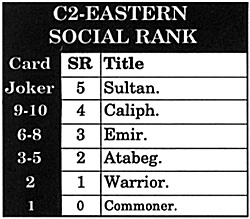 Eastern Armies: An army that requires a minimum of 5 Cos. of Horse Archers in their army list. Eastern armies are allowed to deploy on the table up to 12" from their rear table edge. Their skirmish troops may deploy anywhere within this zone. Other non skirmish troops must be at least 6" in from either flank. Furthermore horse archers are allowed to deploy along any flank - table edge up to 6".
Eastern Armies: An army that requires a minimum of 5 Cos. of Horse Archers in their army list. Eastern armies are allowed to deploy on the table up to 12" from their rear table edge. Their skirmish troops may deploy anywhere within this zone. Other non skirmish troops must be at least 6" in from either flank. Furthermore horse archers are allowed to deploy along any flank - table edge up to 6".
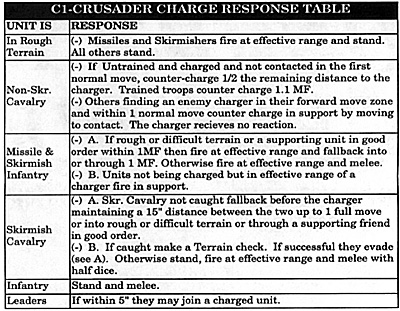 Crusader Response Chart.
Crusader Response Chart.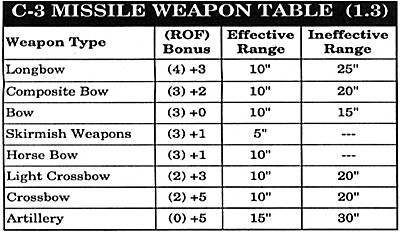 New Missle Weapons
New Missle WeaponsNEW RULES REQUIRED FOR THE FIRST CRUSADE
1. A Numbered card is worth 1 Cos.2. A Face card is worth 2 Cos.
Regrouped horse archers start their first turn either adjacent to their camp or in one of their sides original table corners. On their first turn back they may not perform any other action except reaction. A leader or hero that for any reason left the field with a horse archer unit will return with the first Cos. that is regrouped. As a leader or hero off the field he is counted as "Swept Away" in Day Of Battle. This still allows him an Initiative roll each turn for cards but with a +5 modifier to his die roll. Such a leader or hero may himself be the regrouping leader by using his own cards.
3. An Ace is worth 3 Cos.
4. A Joker is worth 5 Cos.1. Regrouped horse archers may only come from the dispersed pool of horse archer Cos..
2. Dispersed horse archers are any Cos. that voluntarily or invol untarily left the battlefield regardless of the point of exit.
3. Cos. that left with a or as figure casualties are lost for good.
4. A leader or hero that left the field attached to a horse archer unit must return with the first Cos. of horse archers to regroup.
5. Regrouped horse archers may start next to their camp or in an original table edge corner. They may not start within 3" of an enemy unit.
NEW TERRAIN TYPES
 Oasis
Oasis
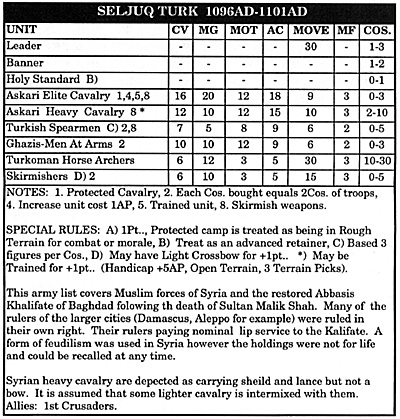 That's it for the rules for The First Crusade. They are few in number and fairly simple to understand with very few changes to the core rules of Day Of Battle. A word of advice to frequent players. It has been determined that the best tactic for the Franks to use is to build themselves a castle out of the terrain and camps and try to hold out until fatigue wears their opponent down. This can however make for a very boring game.
That's it for the rules for The First Crusade. They are few in number and fairly simple to understand with very few changes to the core rules of Day Of Battle. A word of advice to frequent players. It has been determined that the best tactic for the Franks to use is to build themselves a castle out of the terrain and camps and try to hold out until fatigue wears their opponent down. This can however make for a very boring game.
Back to Table of Contents -- Courier #75
To Courier List of Issues
To MagWeb Master Magazine List
© Copyright 1998 by The Courier Publishing Company.
This article appears in MagWeb (Magazine Web) on the Internet World Wide Web.
Other military history articles and gaming articles are available at http://www.magweb.com